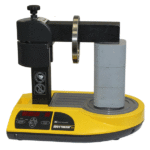During the recent AFPM Reliability & Maintenance Conference and Exhibition in Orlando, FL. Terry O’Hanlon, Publisher of Uptime Magazine and Reliabilityweb.com, gave a speech about proper maintenance practices. One of the subjects was ‘Proper Mounting of Bearings’.
In the late 1960s, one of the large cottonseed processors in Nicaragua had an urgent need for a replacement bearing made by Timken for their oil extraction units.
Not only did I sell them the not readily available industrial bearing from Timken, but I also offered them a FAG Induction Heater for Bearing and/or a DAKE hydraulic press (both products for which we had the representation for Nicaragua) for proper mounting of the expensive bearings. The customer didn’t care for anything else but the bearing. Improper mounting procedure damaged the new cup and cone bearing before it underwent the first revolution on the shaft. The result was a repeat order for another bearing, however this time with a hydraulic press from DAKE.
The revolution in Nicaragua in 1979 brought me to the USA. Again I am selling Bearing Heaters among other maintenance-related tools for predictive and corrective procedures. Unfortunately, it is now easier to sell products that keep manufacturing plants running efficiently in an industrialized country like the USA than in a country of the Third World.
 Some use Induction Heaters for Bearings with an electronic temperature probe, others use so-called Tempsticks which melt at a certain temperature and thus indicate that the bearing is ready to be mounted while others wait until the grease of the bearing starts to evaporate creating a certain smell which for them is a sign that the proper temperature has been reached. Bearings should never be heated beyond 120 degrees Centigrade (250° F) because otherwise, it starts to change the metallurgical structure of the bearing.
Some use Induction Heaters for Bearings with an electronic temperature probe, others use so-called Tempsticks which melt at a certain temperature and thus indicate that the bearing is ready to be mounted while others wait until the grease of the bearing starts to evaporate creating a certain smell which for them is a sign that the proper temperature has been reached. Bearings should never be heated beyond 120 degrees Centigrade (250° F) because otherwise, it starts to change the metallurgical structure of the bearing.
Not only bearings should be properly heated. Gears, crane wheels, and other industrial components are heat-treated in costly processes which easily go to waste due to unprofessional procedures like using a blowtorch resulting in uncontrollable and uneven heating.
As long as maintenance processes are not brought up to modern standards, and as long as Maintenance Departments in every single industry in our country are not given their due status, and as long as Production and Maintenance don’t act in unison, will we not be able to regain dominance in production.
Filed under:
Maintenance Tips by Dieter Seidenthal
